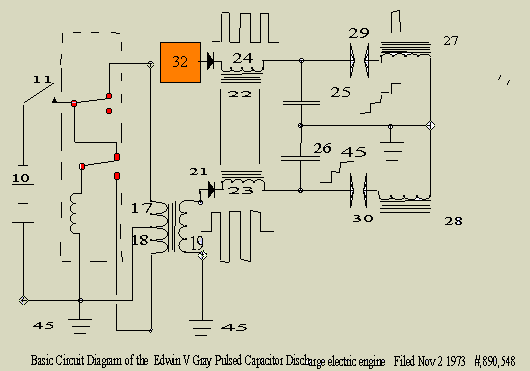

In the early seventies there was constructed an interesting electric motor using energy in storage capacitors to fire across spark gap and to provide power to electromagnets in a repulsion mode
The U.S patent filed November 2 1973 Appl no 412,415 3,890,548
Assigne Evgray Enterprises Inc,Van Nuys Calif
Primary Examiner Robert K.Schaefer
Assistant Examiner John J Feldhaus
Attorney Agent or Firm Gerald L Price.
This is disclosed herein an electric machine or engine in which a rotor cage having an array of electromagnets is rotatable in an array of electromagnets as fixed electromagnets are juxtaposed against moveable move able ones
The coils of the electromagnets are connected in the discharge path of capacitor charged to relatively high voltage and discharged through electromagnetic coils when selected rotor and stator elements are in alignment, or when the fixed electromagnets and movable electromagnets are juxtaposed.
The discharge occurs across spark gaps disclosed in alignment with respect to the desired juxtaposition of the selected moveable and stationary electromagnets.
The capacitor discharges occur simultaneously through juxtaposed stationary moveable electromagnets wound so there respective cores are in magnetic repulsion polarity, thus resulting in the forced motion of moveable electromagnetic elements away from the juxtaposed stationary electromagnetic elements at the discharge ,thereby achieving motion.
In an engine the discharges occur successively across selected ones of the gaps to maintain continuous rotation ,Capacitors are recharged between successive alignment positions of particular rotor and stator electromagnets of the engine.

There is no know engine or motor operated on the principle of the present invention, that a capacitor charged to relatively high voltage from a low voltage dc source is discharged across a spark gap to provide current through motor driven coils in the discharge path., these being solenoids which generate motion by magnetic repulsion of juxtaposed pairs of coils.
The solenoids are preferably configured in motor and stator assemblies to effect motion of the rotor elements with respect to the rotor.
The present invention utilises this principle to provide a rotary motion machine or engine which can develop considerable torque through the magnetic repulsion of rotor and stator cores wound with coils through which capacitors are discharged synchronously with the positioning of rotor coils opposite particular stator coils.
Similarly a linear action can be achieved with a stationary electromagnet juxtaposed against a movable electromagnet and the moveable electromagnet can perform work with a tool or piston attached thereto.
A novel control mechanism in associated with the rotor is the engine to position discharge elements appropriately to create the desired discharge through the electromagnetic when the juxtaposed rotor and stationary electromagnets are in alignment.
The electromagnets in the stator and rotor are so arranged that the control mechanism can advance or retard the discharge points relative to rotor-stator positions for control of rotational speed.
The discharge overshoot or back emf from the collapsing fields in the capacitor discharge is used to engerize external batteries for construction of power.
The recovered energy thus stored may be used to operate equipment associated with the engine or motive force producing device.
The engine or rotary electric machine of the invention is believed to operate on the principle of conservation of energy, in that once rotation is achieved ,current is needed only at the instant of a capacitor discharge in order to advance the rotor.
The rotor moves to the next discharge point on the inertia of the repulsion action.
The capacitor is recharged during the interval and stores energy until discharge at the next rotor stator coil coincidence.Thus, the new engine produces torque and stores the excess energy for subsequence use.
In the linear motion device according to the invention only a single pulse discharge is needed to perform work
The applications of the engine include use as an electric automotive engine which is economical and which can regenerate a part of the energy consumed to provide power to other loads in the automotive vehicle. As a linear actuator an economical use of power is possible because each stroke will result from a single discharge pulse of a capacitor through a coil..
